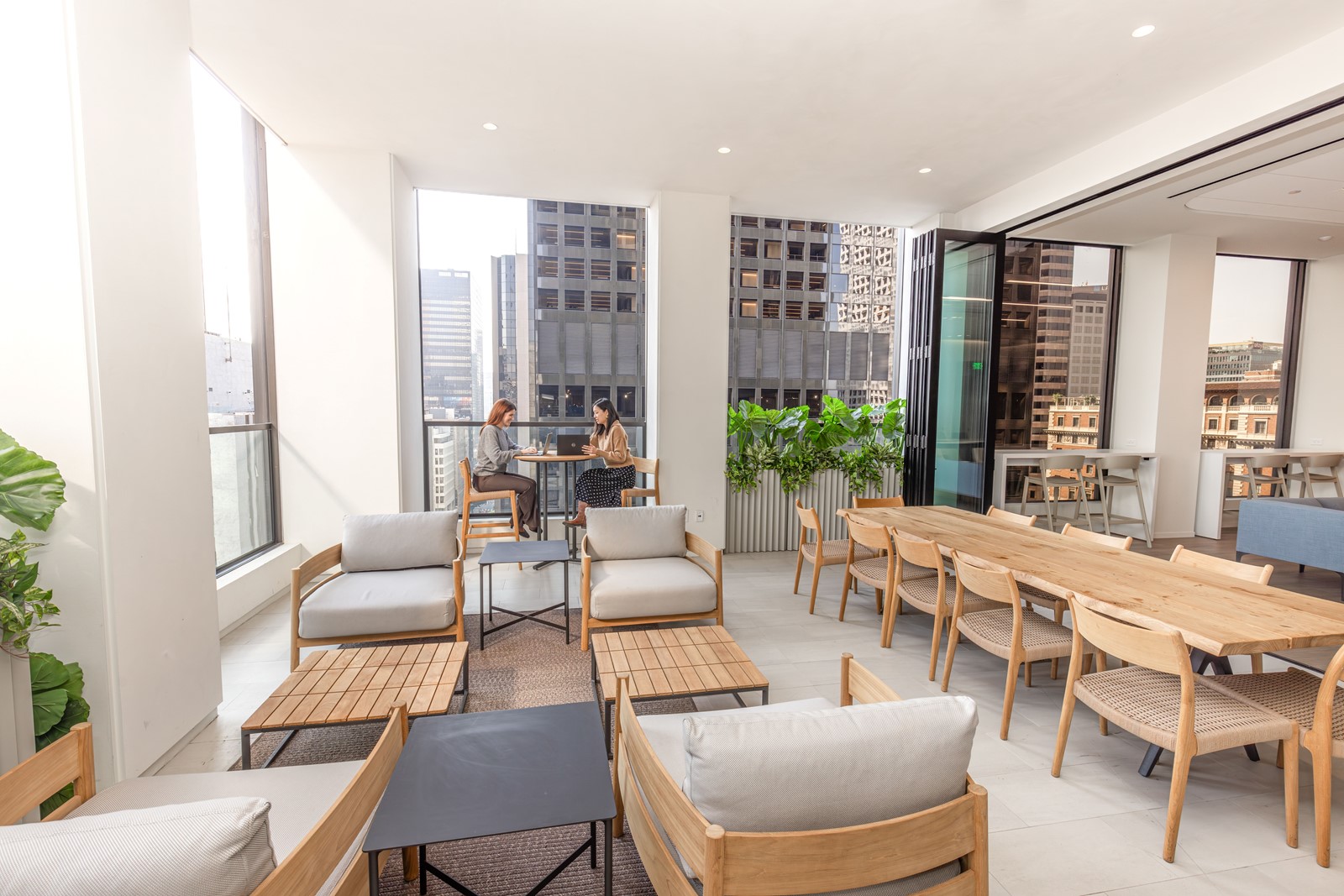
The great office restructuring has begun — thanks to the pandemic’s passing.
In January, Kerin Van Andel, JLL executive vice president of workplace strategy, lost her nameplate on the wall outside her JLL office on the 13th floor of a twin tower skyscraper complex on South Flower Street in downtown Los Angeles.
She previously occupied a square office, but when the downtown offices were remodeled, she moved to a breezy area where windows can be opened and quarter-paneled glass doors fold back — giving way to a terrace balcony.
The collaborative office space — which JLL calls hoteling — replaced the 10-foot-by-10-foot square offices with open space.
Tables and benches, huddle rooms for meetings and electronic gadgetry were added to Wi-Fi hot spot areas for workers to plug in their laptops and cellphones. There are the usual conference rooms, but also phone booth-sized rooms for private conversations with clients.
“We have great big events there,” said Van Andel of her new L.A. digs.
“I just drop into a 6-foot long benching type desk. I’ve got monitors. I’m engaging with people around me. Sometimes I put on my headphones so that I can focus to get something done,” she said. “You get this amazing ocean breeze because you’re on the 13th floor. We have yet to have a day when you couldn’t find a desk.”
JLL says these kinds of office spaces are catching on, though they’ve been around for years — such as Mazda North America headquarters, which debuted in 2017 in an Irvine Co. tower at the Irvine Spectrum Center.
The pandemic helped to push more big employers into rethinking their workplaces.
“Landlords teamed up, trying to encourage employees to come back to work, come in for a couple of hours. They’ve said we’ll throw away the dead office plants, you can say hello to your co-workers and have lunch in a restaurant, and you get to leave early,” observed Carl Muhlstein. The Los Angeles real estate professional launched his own boutique firm after decades of working for major brokerages on deals with high-profile Hollywood companies and properties.
Whether that works is still up for debate. Muhlstein thinks the perks don’t “really work that much from an optionality point of view.”
“Because if you’re sitting at home, you can get dressed and work there instead of sitting on the freeway where there’s so much traffic,” he said. “It’s like the offices are 50% occupied and the freeways are 150% occupied, gas is $5 a gallon and when I pull up to the parking garage, my monthly pass no longer lets me in, and it’s $4 for 10 minutes.”
“I think I’ll make a U-turn and go back home.”
Vacancy rates show that getting workers back to the office remains a challenge.
According to Cushman & Wakefield, vacancy rates in Orange County reached 18.8% in the fourth quarter of 2024 — up 40 basis points since the end of 2023. The soft growth is a sign of continued uncertainty around space needs, according to the commercial real estate services company.
Vacancy in the greater Los Angeles office market climbed to 24.9% — up 240 basis points from the end of 2023. This marked the 10th consecutive quarter of occupancy losses, with tenants returning nearly 258,000 square feet of office space to market in the 2024 fourth quarter, according to Cushman & Wakefield.
In the Inland Empire, vacancy rates increased to 9.2% — up 40 basis points from the end of 2023. Despite this uptick, the office market continues to see steady leasing demand, particularly from health care providers and local small businesses, as more residents and companies relocate from higher-cost coastal areas, according to Cushman & Wakefield.
Dangling enticements
Big companies reupping leases are using enticements to get workers back in the office, he said.
“Work looks like a business center or the Admirals Club (of American Airlines) at the airport. The day of a private office assigned a corner office for a partner, I think those days are history for many employers,” Muhlstein said.
Cole Martinez, a principal of business development with workplace design service firm Unispace in San Diego, said employers are offering enticements in high-end office space that has selling points — like patios, nearby shopping and restaurants, and tech amenities.
“What we’re seeing is a flight to quality,” Martinez said. “Employers are attracting people back in to work by new development, the high-end class space. What the employer is really competing against right now are the benefits of working from home. Technology is playing a huge factor.”
Jeff Ingham, JLL’s senior managing director in charge of leasing commercial real estate in Orange County, noted another trend that emerged as a result of the pandemic.
“In suburban markets, where there’s plenty of surface parking, you’ll see a lot of buildings becoming functionally obsolete, and they’re being converted to industrial uses, and more recently, converted to residential,” he said. “There’s a bigger need for housing than office space.”
As evidence, JLL cited the Irvine Co.’s recent proposal to replace two MacArthur Court offices with 700 apartment units.
“That’s the trend, and I’d say that’s not going to change,” Ingham said. “There’s not going to be a big influx of — I’ll call it administrative jobs, or back office employees — coming back to the office.”


 PREVIOUS ARTICLE
PREVIOUS ARTICLE
